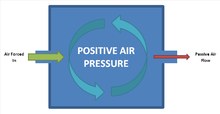This article needs additional citations for verification. (May 2020) |

Positive pressure is a pressure within a system that is greater than the environment that surrounds that system. Consequently, if there is any leak from the positively pressured system, it will egress into the surrounding environment. This is in contrast to a negative pressure room, where air is sucked in.[1][2]
Use is also made of positive pressure to ensure there is no ingress of the environment into a supposed closed system. A typical example of the use of positive pressure is the location of a habitat in an area where there may exist flammable gases such as those found on an oil platform or laboratory cleanroom. This kind of positive pressure is also used in operating theaters and in vitro fertilisation (IVF) labs.[citation needed]
Hospitals may have positive pressure rooms for patients with compromised immune systems. Air will flow out of the room instead of in, so that any airborne microorganisms (e.g., bacteria) that may infect the patient are kept away.[2]
This process is important in human and chick development. Positive pressure, created by the closure of anterior and posterior neuropores of the neural tube during neurulation, is a requirement of brain development.
Amphibians use this process to respire, whereby they use positive pressure to inflate their lungs.
- ^ Angstrom-Tech-Admin (2016-04-20). "What's the Difference Between Positive and Negative Air Pressure Cleanrooms?". Angstrom Technology. Retrieved 2020-05-01.
- ^ a b "Negative and Positive Pressure Rooms 101 | Hospital Infection Control". Air Innovations. 2019-04-29. Retrieved 2020-05-02.